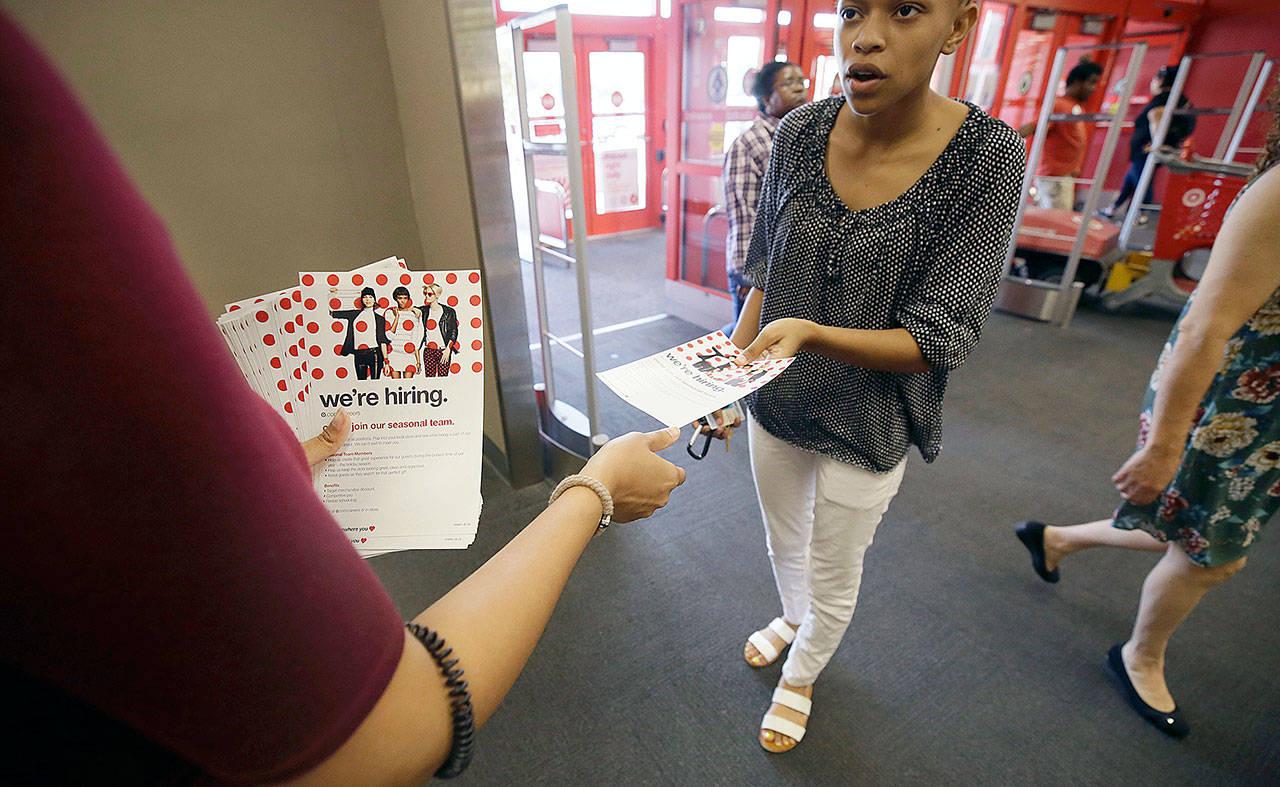By Christopher Rugaber / Associated Press
WASHINGTON — With U.S. unemployment at a 17-year low and businesses complaining that they can’t fill jobs, you might expect pay to be rising sharply as companies try to attract or keep workers.
It’s not. The October jobs report showed that pay gains remain sluggish, and the explanations include weak worker productivity and a still-low proportion of adults with jobs. These are long-running trends that still bedevil the economy despite its steady improvement.
Employers added a solid 261,000 jobs last month, the government said Friday, in part because many businesses in Texas and Florida re-opened after having been forced to shut down in September when Hurricanes Harvey and Irma struck.
The unemployment rate reached 4.1 percent, the lowest level in nearly 17 years, from 4.2 percent in September. But the rate dropped for a less-than-encouraging reason: Many people stopped looking for work and so were no longer counted as unemployed.
Still, Friday’s data showed that the hurricanes, for all their fury, hardly knocked the economy or the job market off course. Over the past three months, job growth has averaged 162,000— similar to the pace of hiring before the storms.
“Looking through the volatility from the hurricanes, the U.S. job market is in good shape,” said Gus Faucher, chief economist at PNC Financial.
Normally, with the unemployment rate ultra-low, businesses are forced to raise pay significantly to fill jobs or to retain existing employees. The last time the jobless rate was this low, in 2000, average hourly pay was surging at a 4 percent annual pace.
Then was then. In October, by contrast, wages crept up just 2.4 percent from a year earlier, the government said Friday. Though that’s double the pace of five years ago, it’s nearly a half-point less than the year-over-year rate in September.
It’s particularly surprising given that some employers say they’re desperate to hire. Mike Bolen, chief executive of McCarthy Building Companies in St. Louis, said he needs more electricians, carpenters, and laborers, as well as engineers, marketing and IT support. McCarthy has 16 offices and employs 4,000.
“We like to say there is no unemployment,” Bolen said. “We have a shortage of everything, everywhere.”
Four years ago, there would be about 30 potential employees in a union hall waiting for job postings, he said. Now, the halls are empty, and there are posted jobs with no takers.
Bolen is working with high schools and community colleges to train and recruit young people. He says he’s raised pay in recent years and offers attractive wages: An entry-level laborer in Denver can start at $16 to $20 an hour and earn up to $30 after one year.
Homebuilders also say they would construct more homes — which could relieve a housing shortage that is depressing sales — if they could find more workers.
Still, the construction industry as a whole isn’t raising pay much: Wages rose just 2.2 percent in October from a year earlier, Friday’s report showed. That’s even lower than the economy-wide average.
Reed Nyffeler, CEO of Signal 88 Security, is similarly frustrated. He says job applications have fallen 90 percent since the recession. The company, which provides security in 200 U.S. markets, needs security officers and professional staff.
“We have franchisees telling me every day they are turning down contracts because they can’t find workers,” Nyffeler said.
Signal 88 has raised starting pay for security officers from $9.25 an hour to $11.25 in the past two years. But other low-wage employers have also lifted pay, Nyffeler said, thereby creating new competition for Signal.
Many potential applicants can’t pass drug tests, Nyffeler says, while others can live off government benefits.
His ability to raise pay, Nyffeler says, is limited because his clients are reluctant to pay more for his company’s services. Signal 88 bills at $17 an hour, on average. The company tries to raise prices each year when it renews contracts, but many of its clients then threaten to seek alternatives.
Other companies appear in similar circumstances: Price increases throughout the economy are weak. Inflation rose just 2.2 percent in September from a year ago and would have been lower without a spike in gas prices.
One way out of the conundrum would be to raise worker efficiency. When workers become more productive — when their output per hour rises — companies can afford to pay more without raising prices.
Yet productivity growth has been weak since the recession ended in 2009. It grew just 1.2 percent a year, on average, in the past decade. That’s less than half the growth rate before the recession. One reason productivity has been so sluggish is that companies haven’t invested much in machinery, technology and other equipment that could boost workers’ output.
The Trump administration and Republican Congress are pushing a steep cut in the corporate tax rate from 35 percent to 20 percent in hopes of encouraging more productivity-boosting investment. But some economists argue that the increased profits stemming from the tax cut will be used mainly to boost dividends and share buybacks.
Jed Kolko, chief economist at Indeed, the job listing website, notes that the proportion of adults with jobs remains below pre-recession levels. That raises the possibility that there are more Americans available to work than the unemployment rate suggests. It also means that if employers can hire them, they may not feel pressure to raise pay.
Last month, 78.8 percent of adults aged 25 through 54 had jobs. That figure has risen 1.5 percentage points in the past two years. Yet it topped 81 percent in 2000, the last time unemployment was this low.
“By that measure, the labor market is not unusually tight,” Kolko said.
Talk to us
> Give us your news tips.
> Send us a letter to the editor.
> More Herald contact information.

























